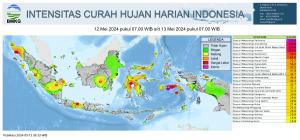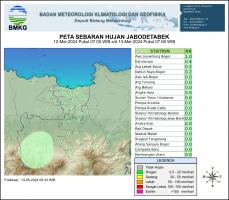| Current Cyclone | Cyclone Outlook | After Events Report | Historical Cyclone | Annual Reports | Cyclone Names | Learn About TC |
Global Guide to Tropical Cyclone Forecasting. http://www.cawcr.gov.au/bmrc/pubs/tcguide/globa_guide_intro.htm
Khotimah, M.K. Siklon Dekat Ekuator.
Khotimah, M.K., 2008. Klimatologi Siklon Tropis Di Sekitar Indonesia. Buletin Meteorologi dan Geofisika.
Khotimah, M.K., A. F. Radjab, M. Budiarti. 2009. Siklon Tropis Kirrily: Anomali di Dekat Ekuator. Buletin Meteorologi dan Geofisika. April 2009.
Laporan Kegiatan Tropical Cyclone Warning Centre (TCWC) Jakarta 2007.
Laporan Tahunan 2008 Jakarta Tropical Cyclone Warning Center BMKG.
Operational Directive Tropical Cyclone Warning Centre (TCWC) Jakarta 2010. V.1.0 Januari 2010.
Tropical Cyclone Records Central Pasific Hurricane Center, National Weather Service http://www.prh.noaa.gov/cphc/pages/FAQ/Tropical_Cyclone_Records.php
WMO. Technical Document WMO/TD-No.292 Tropical Cyclone Programme Report No. TCP-24 Tropical Cyclone Operational Plan For The South Pasific and South-East Indian Ocean 2008 edition.
« Jakarta TCWC
| Current Cyclone | Cyclone Outlook | After Events Report | Historical Cyclone | Annual Reports | Cyclone Names | Learn About TC |
Early Detection for a Better Life
Brief history
- Indonesia has been being a member of RA-V TCC since it establishment by RA V-IX in 1986 and responsible to operate Jakarta TCWC covering the sea area of 90° - 125°E and 10°S - Equator.
- RA V-XII in1998 recommended Australia to assume warning responsibilities covers Indonesia as interim measure.
- RA V-XIII recommended that BMG postpone its responsibility to operate TCWC for 2005/06 TC season, and again for 2006/07.
- TCP-24 2006 Edition stated that Indonesia takes over responsibility from Australia starting 2007/2008 cyclone season.
- A major project to assist BMKG to establish Jakarta TCWC was completed at the end of 2007. Jakarta TCWC officially inaugurated by BMG Director General at March 24, 2008.
- Jakarta TCWC made its first activation during TC Durga (April 22 - 25, 2008).
- RA V TCC-XIII grant BMKG proposal to extend Jakarta TCWC area of responsibility to be area within coordinate 0°S 090°E, 10°S 090°E, 10°S 120°E, 11°S 120°E, 11°S 128°E, 09°S 128°E, 09°S 141°E, and 0°S 141°E, which covers almost all territory of southern Indonesia.
Operation of Jakarta TCWC
- Background
-
WMO MANDATORY
WMO Tropical Cyclone Opertional Plan For The South Pacific And South East Indian Ocean (TCP-24, 2006 Edition) stated Indonesia would take over responsibility at the start of the 2007/2008 cyclone season. -
INTERNAL INTEREST OF BMG
Though Indonesia is very rarely tracked by TC, the occurrence of TC near the region, gives impact to Indonesia weather variability.
-
- Task and responsibilities
-
Forecasts and warnings for the general population
Responsible for warnings on tropical cyclones and related hazardous weather phenomena for the general population on the coastal waters and land areas of Indonesia -
Forecast and warning for open sea
Responsible for marine tropical cyclone forecasts and warnings in the area of responsibility within coordinate 0°S 090°E, 10°S 090°E, 10°S 120°E, 11°S 120°E, 11°S 128°E, 09°S 128°E, 09°S 141°E, and 0°S 141°E.
-
« Tropical Cyclone Warning Centre (TCWC)
Reference »
| Current Cyclone | Cyclone Outlook | After Events Report | Historical Cyclone | Annual Reports | Cyclone Names | Learn About TC |
Each cyclone is named. In Atlantic Ocean or in Australia region, cyclone name is adopted from human name. Though in Pasific Ocean, cyclone name is more variable such as Cyclone Anggrek (orchid in Indonesia language), Durian (a very rich flavoured fruit), Nuri (BLUE crowned parroquet in the Malay language), Halong (a beautiful bay in Vietnam), Mekhala (angel of thunder), Bavi (a mountain chain in northern Viet Nam), and Fengshen (God of wind).
« Cyclone Impact
Tropical Cyclone Warning Centre (TCWC) »
| Current Cyclone | Cyclone Outlook | After Events Report | Historical Cyclone | Annual Reports | Cyclone Names | Learn About TC |
The main goal of a Tropical Cyclone Warning Centre is to minimalize loss of life and property and other impacts of tropical cyclone occurrence by providing accurately and timely warning to the threatened community.
A tropical cyclone warning system at least involving four parties :
- Meteorological agency, that provide the warnings
- Mass media, that broadcast the warnings
- Disaster management institution, at national and regional level
- Threatened community
There are Tropical Cyclone Warning Centres all over the world to monitor every occurrence of tropical cyclone. Everywhere, this monitoring is continuously performed everyday for 24 hours by using various kind of technology, from satellite, radar, and manned or unmanned observation stations. It purposes are to monitor the development of cyclone, it movement and intensity.
Tropical Cyclone Warning Centre is also responsible to provide tropical cyclone related warning and information and dissiminate them to the threatened area.
Basically there are two kinds of tropical cyclone warning, i.e. Coastal Waters and Land Area Warning and Warning for Open Sea. Each member of Regional Bodies is responsible to produce Warning for their coastal waters and land area. Though Warning for Open Sea is made by the concerned Tropical Cyclone Warning Centre according to their Area of Responsibility.
Table. WMO Regional Bodies, Committee and their Area of Responsibility
| Name | Area of Responsibility |
|---|---|
| WMO/Regional Association I (RA I) Tropical Cyclone Committee | Southwest Indian Ocean |
| WMO/Regional Association IV (RA IV) Hurricane Committee | North Atlantic Ocean, Caribbean Sea, Gulf of Mexico and the eastern North Pacific |
| WMO/Regional Association V (RA V) Tropical Cyclone Committee | South Pacific Ocean and southeast Indian Ocean |
| WMO/ESCAP Panel on Tropical Cyclones | Bay of Bengal and Arabian Sea |
| WMO/ESCAP Typhoon Committee | Japan and Southeast Asia |

| Current Cyclone | Cyclone Outlook | After Events Report | Historical Cyclone | Annual Reports | Cyclone Names | Learn About TC |
Concerning its large size, strong wind and cloud cover, cyclone caused significant impact to places it passed. Those are strong wind, heavy rain continuous for hours or even for days with a chance of flood, high wave, and storm surge.
Cyclone passes ocean resulting high seas, heavy rain and strong wind is dangerous for shipping. Cyclone spin the water, whirl them to result high wave. In land, strong wind destroys vehicles, buildings, briges and other constructions, change them into dangerous flying debris. Storm surge or sea level rise caused by cyclone is the most hazardous impact land may have.
According to history, 90% cyclone is deadly. Cyclone spinning reaches land and vertical windshear around may produce tornado. Tornado may also form as resulted by vorticity within the cyclone eyewall.
Direct Impact
Direct impact means cyclone impact within cloud band area. They could be high wave, storm surge, heavy rain and strong rotating wind.
Indonesia experience cyclone direct impact when Kirrily, a rare event of cyclone development near equator occurred above Kai Islands at 27 April 2009. Kirrily brought heavy rain and storm surge within the area. It is reported that tens of houses destroyed, tens others submerged, roads broken, and high waves occurred from 26 to 29 April. Rainfall recorded in Tual is 20 mm, 92 mm and 193 mm for 27, 28 and 29 April 2009.

Remote Impact
Climatologically, Indonesia is not tracked by tropical cyclone, yet cyclone occurrence around the area, especially those developed in Western North Pasific, South East Indian Ocean and Australia changes weather pattern in Indonesia. Those weather pattern changes bring remote impact through the area.
Cyclone remote impact may exist through:
-
Convergence zone.
Tropical cyclone occurs at the northern or western waters of australia often produce convergence zone above Java, Java Sea, West Nusa Tenggara, East Nusa Tenggara, Banda Sea, Timor Sea, to Arafuru Sea. This convergence zone brings convective cloud with heavy rain over the area.
Convergence zone may looks like elongated thick cloud area when it seen from weather satellite imagery, as it looks like comma tail of the cyclone.
An example of this phenomenon is when there is cyclone George in 2 March 2007 with cyclone tail along East Java to East Nusa Tenggara. Rainfall observed at the moment in Ruteng, Waingapu, Rote and Kupang are 172mm, 52 mm, 78 mm and 73 mm.
-
Shear area.
Cyclone occurrence in south eastern Indian Ocean offen form shear area over southern Sumatra or western Java that will also experience heavy rain.
« Near Indonesia Cyclone Season
Cyclone Name »












